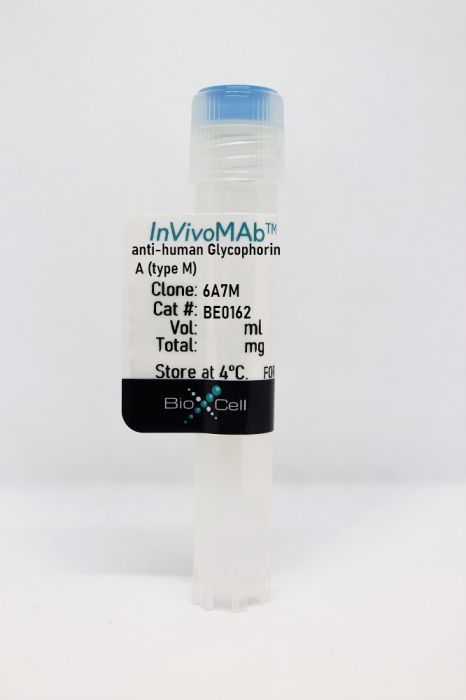InVivoMAb anti-human Glycophorin A (type M)
Product Details
The 6A7M monoclonal antibody reacts with the human glycophorin A (GPA) M allele also known as GYPA and CD235a. Glycophorin A is encoded by the GYPA gene and is a 151 amino acid sialoglycoprotein expressed on the membrane of human erythrocytes and erythroid progenitor cells. The GYPA gene has 2 allelic forms M and N, which differ by two amino acids.Specifications
| Isotype | Mouse IgG1, κ |
|---|---|
| Recommended Isotype Control(s) | InVivoMAb mouse IgG1 isotype control, unknown specificity |
| Recommended Dilution Buffer | InVivoPure pH 7.0 Dilution Buffer |
| Conjugation | This product is unconjugated. Conjugation is available via our Antibody Conjugation Services. |
| Immunogen | Type O, Rh- human erythrocytes and purified glycophorin A |
| Reported Applications | in vitro GPA blockade |
| Formulation |
PBS, pH 7.0 Contains no stabilizers or preservatives |
| Endotoxin |
<2EU/mg (<0.002EU/μg) Determined by LAL gel clotting assay |
| Purity |
>95% Determined by SDS-PAGE |
| Sterility | 0.2 µm filtration |
| Production | Purified from cell culture supernatant in an animal-free facility |
| Purification | Protein G |
| RRID | AB_10950144 |
| Molecular Weight | 150 kDa |
| Storage | The antibody solution should be stored at the stock concentration at 4°C. Do not freeze. |
Recommended Products
in vitro GPA blockade
Namdar, A., et al. (2019). "CD71(+) Erythroid Cells Exacerbate HIV-1 Susceptibility, Mediate trans-Infection, and Harbor Infective Viral Particles" mBio 10(6). PubMed
CD71(+) erythroid cells (CECs) have a wide range of immunomodulatory properties. Here, we show that CECs are expanded in the peripheral blood of HIV patients, with a positive correlation between their frequency and the plasma viral load. CECs from HIV patients and human cord blood/placenta exacerbate HIV-1 infection/replication when cocultured with CD4(+) T cells, and that preexposure of CD4(+) T cells to CECs enhances their permissibility to HIV infection. However, mature red blood cells (RBCs) do not enhance HIV replication when cocultured with CD4(+) T cells. We also found CECs express substantial levels of the NOX2 gene and via a mitochondrial reactive oxygen species (ROS)-dependent mechanism possibly upregulate NF-κB in CD4(+) T cells once cocultured, which affects the cell cycle machinery to facilitate HIV-1 replication. The complement receptor-1 (CD35) and the Duffy antigen receptor for chemokines (DARC) as potential HIV target molecules are expressed significantly higher on CECs compared to mature red blood cells. Blocking CD35 or DARC substantially abolishes HIV-1 transmission by RBCs to uninfected CD4(+) T cells but not by CECs. In contrast, we observed CECs bind to HIV-1 via CD235a and subsequently transfer the virus to uninfected CD4(+) T cells, which can be partially blocked by the anti-CD235a antibody. More importantly, we found that CECs from HIV-infected individuals in the presence of antiretroviral therapy harbor infective viral particles, which mediate HIV-1 trans-infection of CD4(+) T cells. Therefore, our findings provide a novel insight into the role of CECs in HIV pathogenesis as potential contributing cells in viral persistence and transmission.IMPORTANCE Immature red blood cells (erythroid precursors or CD71(+) erythroid cells) have a wide range of immunomodulatory properties. In this study, we found that these erythroid precursors are abundant in the human cord blood/placental tissues, in the blood of HIV-infected and anemic individuals. We observed that these cells exacerbate HIV-1 replication/infection in target cells and even make HIV target cells more permissible to HIV infection. In addition, we found that HIV gets a free ride by binding on the surface of these cells and thus can travel to different parts of the body. In agreement, we noticed a positive correlation between the plasma viral load and the frequency of these cells in HIV patients. More importantly, we observed that infective HIV particles reside inside these erythroid precursors but not mature red blood cells. Therefore, these cells by harboring HIV can play an important role in HIV pathogenesis.



